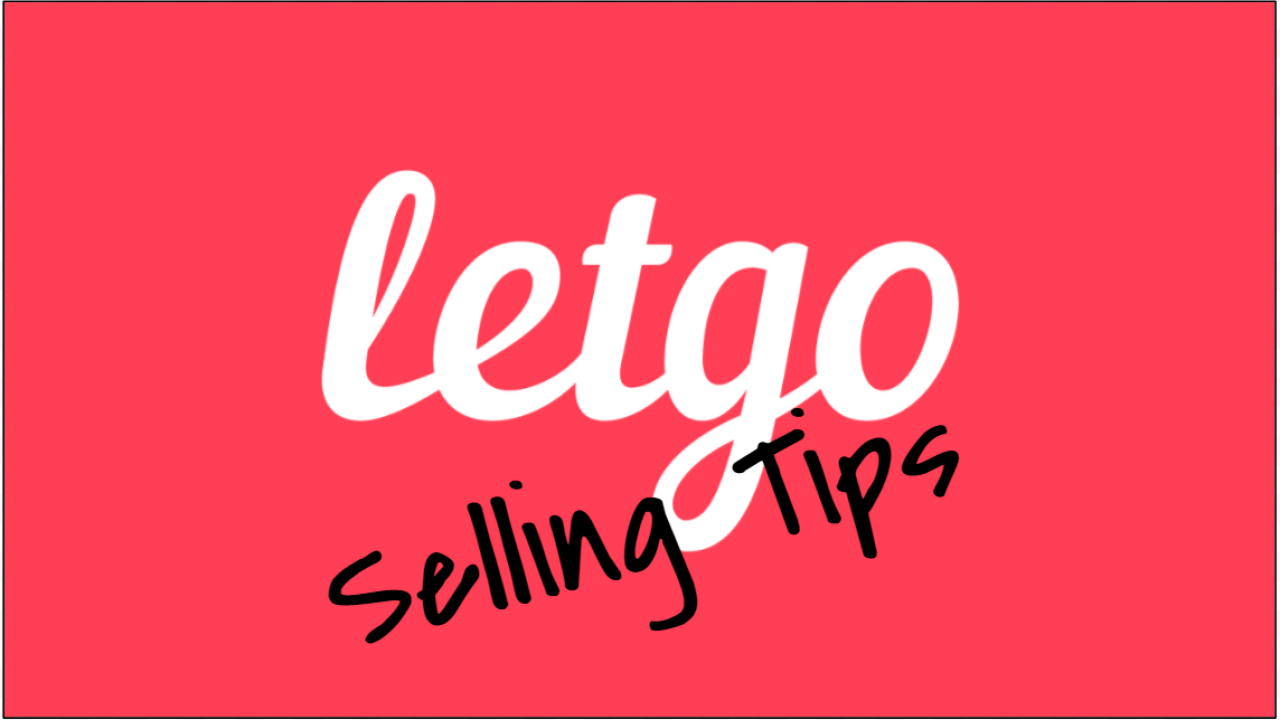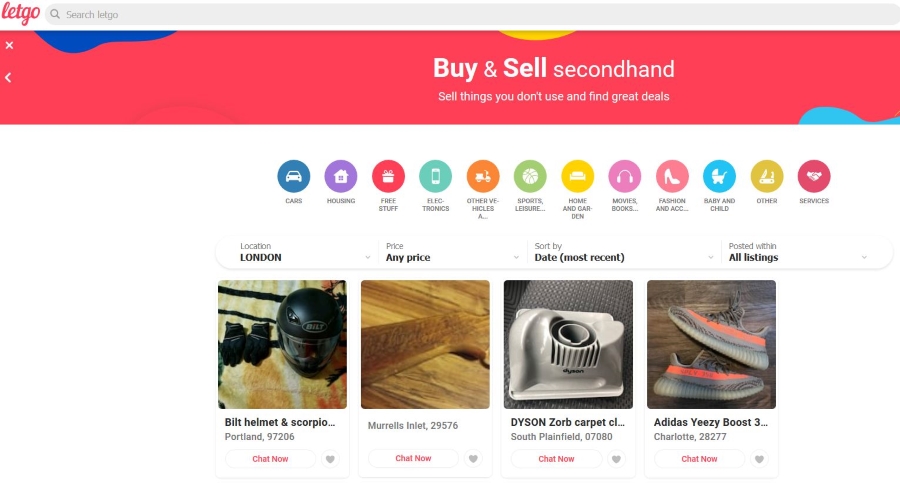Tips for Selling on Letgo

Your garage is filled with stuff you never use and maybe that you never even opened. Your newborns have turned into elementary school kids, and you’ve got a ton of baby stuff clogging every hall closet and attic space. You lost those 20 pounds (or gained them) and now you have a closet full of clothes that don’t fit now and never will fit again. In short, you’ve got a lot of stuff and a shortage of space and cash. So why not reverse that situation? A friend tells you about Letgo, the popular app for community-based (read as: local) buying and selling, like a cross between eBay and Craigslist. Eager to get started, you take a quick picture of your kid’s old baby bouncer and that pile of fat jeans and wait for the contacts to roll in. Only… they don’t. Nothing happens, except for some crickets and tumbleweeds. What did you do wrong? Surely, someone needs this stuff.
And someone does, so if it isn’t selling then you might be doing it wrong. It happens; knowing what our old stuff is worth, and knowing how to market it, aren’t necessarily skills that everyone has right off the bat. Like any other skill, it takes some practice. If you’re having trouble unloading your stuff on Letgo, consider the following tips to attract more buyers.
Tips for Attracting Buyers
The key to selling anything on Letgo is the same on any other marketplace app: you need to attract buyers looking to spend money. It isn’t enough to put a simple item listing online and hope that people find their way to a vague description of what you’re selling. Instead, you’ll need to be smart about how you design your Letgo item listing to make sure it looks alluring to the general consumer. Here’s how:
-
- Make your stuff look good. The app markets itself as being about just taking a quick snapshot and instantly having someone show up who wants it. In real life, presentation is important. In other words, don’t just take a quick picture. Take a good picture. Make sure the item is easy to see with good lighting and a contrasting background. Take pictures from multiple angles and share them all. Buyers are going to be inherently, and rightfully, suspicious of items that look “hidden” or “obscured.” Even if it’s just a case of you not being a born photographer, they’ll assume it’s not in as good condition as you suggest and that you’re trying to pull a fast one. Show them you have nothing to hide and put some effort into the pictures. That means clearly showing any damage ahead of time as well as putting in images that show your items in the best possible light.

-
- Be descriptive. Letgo lets you put in a lot of description for your items. Take advantage of it. (Have a hard time typing in a bunch of description on your phone’s tiny little keyboard? Use voice typing to speed up the process.) Talk about the size, color, fabric, or whatever else might be relevant. A picture may say a thousand words, but you don’t know what those thousand words are, so never assume that the picture speaks for itself. The more care you put into your post, the more buyers will be likely to trust you.

-
- Price your item appropriately. Unless you did something special to renovate or renew the item, it’s not going to be worth as much as you paid for it when it was new. Don’t expect to get your money back. On the other hand, if you price an item too far below what it might be worth, people might get suspicious. They’ll think you’re not being honest about the condition, or that it’s stolen, or that there’s something wrong with it. You wouldn’t trust a $20 iPhone, and that logic can be applied to most other things, too. A quick look on Ebay and Amazon can give you the general range of what items like yours are going for online, and you don’t have to compete on shipping costs, either.
- Use the bump feature. Letgo allows you boost your item for a $1.99 fee, sending your item back up to the top of the listings. This feature won’t be available immediately. Your item needs to be sitting around for a little while before this option becomes visible. Don’t go overboard on bumping, though; the truth is that if your item didn’t sell when you posted it, it’s relatively unlikely to sell when you bump it, and now you’re out two bucks. But don’t assume that it’ll never sell; there’s a “long tail” of items on Letgo, and you can expect things to sell eventually if they are in good condition and the price is right.
The dark side of Letgo is that just because someone shows up for your item, that doesn’t mean they intend to pay for it. In fact, they might be there to rip you off. Where there are buyers and sellers, there are also scammers. Consider the following tips for using Letgo safely.
Letgo Safety Tips
Once you have an interested buyer, you’ll need to follow some tips to ensure you aren’t landing yourself in a bit of trouble. Just like with eBay, Craigslist, or any other online marketplace, Letgo can be dangerous if you aren’t proactive and protective of your personal belongings. Here’s a checklist to avoid being hurt or scammed out of your product:
-
- Meet in person. This may feel risky from a personal safety perspective, but it is better from a financial safety perspective. If you don’t meet in person, then you are relying on a promise: the promise that you’ll get paid if you mail your item. That or you’re asking the other person to rely on a promise, which may feel risky to them. Letgo is about in-person transactions.
- Meet in public. Never give a buyer your personal address and don’t ask them to give you theirs. Meet in a place with lots of people. Coffee shops make excellent meeting spots, and if you’re worried about the transaction then a coffee shop probably has cookies for you to eat your feelings.
- Accept cash only. This may seem punitive, especially in the age of credit cards and electronic payments. However, trading your item for hard cash on the spot is the only way you can be certain that you’ll be paid. Checks bounce. The promise of electronic transfers can be reneged on. Credit payments can be disputed. Cash, on the other hand, is money that can’t evaporate. (But don’t take any bill larger than a 20. In-person sales have become a magnet for counterfeiters. If someone insists on using a $50 or a $100, ask them to go change it at a local store. If they suddenly change their mind about making the deal, congratulations, you just avoided being victimized.)

- Work only with verified users. Users who have their account verified are users who you can trust are who they say they are. It’s easy to get your account verified in Letgo. Therefore, if the account is unverified, you have to wonder what’s going on.
- Never give out your personal information. We already mentioned never giving out your address. Don’t stop there. Avoid giving out your personal contact information (unless you need it to connect with the person), your social media information, your place of business, etc. Just don’t tell them what they don’t need to know. Absolutely never give out financial information (like your credit card or account information).
- If in doubt, let them go! There are other fish in the proverbial sea. There are also other buyers in Letgo. If something doesn’t feel right, move on to another buyer.
These tips will protect you from users who might try to get away with a little free stuff. However, there are more involved scams that run on platforms like Letgo and Craigslist. Learn the signs and report them to Letgo and to the Federal Trade Commission (FTC). But how do you know if something is a scam?
Spotting Scams
Picture this: you have finally found a buyer for your baby’s high chair. In fact, she wants the high chair and about $150 in baby clothes and toys. But the buyer isn’t from around here. She is moving to town in a couple of weeks with her family and, in the meantime, wants to have a mover come pick up the items. She’s going to send you a $250 check, $175 is for the stuff and $75 is to pay the mover when he arrives. Already, there are some red flags here. She’s putting an awful lot of faith in someone she doesn’t know–so much so that she’s willing to give you extra money. She also seems to be paying that mover rather generously to pick up a small bunch of baby stuff. But she seems so earnest, and you want to help out a new mom and her family.
Stop right there.

You’ll deposit the check, take out the money, and pay the man who comes to pick up the baby stuff. Then, sometime shortly thereafter, that check will bounce. In the end the scammers will have gotten away with all of your stuff and an extra $75.
This is a common scam on sites like these, we’re sad to say. Just type ‘fake check scam’ into any search engine and you’ll get pages of horror stories. However, it’s not the only kind of scam to watch out for. Scams can be difficult to spot, but not impossible. Look out for buyers wanting to send you checks for more than the agreed upon price. Look out for people asking for personal financial information (like people asking for your account number so they can transfer you funds electronically). Basically, look out for anything that isn’t a simple “I sell – you buy” transaction. Odds are, it’s a scam.
Have any great tips for selling on Letgo, or on avoiding scams? Share them with us below!















30 thoughts on “Tips for Selling on Letgo”
We are downsizing, so a ton of stuff from a 40 year marriage is going going gooooone ;-)
It will pull up all the pics on your phone. You just click the pics you want to use & the order you want them displayed. I like to get fancy with my first pic, then various different angled shots. Hint: when editing my pics, I click the favorites button (on your phone, not the app) then when you go to add photos to the app (or anywhere) instead of camera roll, change to favorites, so you don’t have to scroll through a bunch of pics to find the ones you want for your listing.
Last hint: get photo vault, just in case..this app hides THOSE pics from nosy people going through your phone
Are you clearly showing the items so they can be seen at all angles? Did you show the receipt with the original price on it? You said the pool was brand new but how brand new? A month, 6 months, a year? Make sure to be descriptive, show clear pictures.
2.) Both pieces are large and heavy furniture. I appreciate your warning about people coming to my house. Butt, I can’t bring pieces you Starbucks. What do I do?
Thank you in advance for your consideration and assistance.